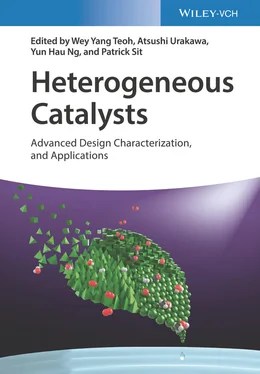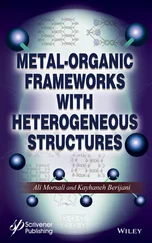34 34 Lou, S.N., Scott, J., Iwase, A. et al. (2016). Photoelectrochemical water oxidation using a Bi2MoO6/MoO3 heterojunction photoanode synthesised by hydrothermal treatment of an anodised MoO3 thin film. J. Mater. Chem. A 4: 6964–6971.
4 Synthesis and Design of Carbon‐Supported Highly Dispersed Metal Catalysts
Enrique García‐Bordejé
Instituto de Carboquímica (ICB‐CSIC), Department of Chemical Processes and Nanotechnology, Miguel Luesma Castán 4, E‐50018 Zaragoza, Spain
Activated carbon is typically the choice of industry as catalyst supports for noble metals for hydrogenation and oxidation in liquid phase due to its outstanding properties such as resistance to basic/acidic media, chemical inertness, high surface area, and the easy recovery of the noble metals by calcination. Carbon black, consisting of microporous and graphitic carbon, is the benchmark support for noble metals used in electrocatalysis due to its excellent conductivity (see for examples, Chapter 30for electrocatalytic water splitting, and Chapter 32for fuel‐cell‐related electrocatalytic reactions). More recently, development of carbon‐based catalysts have been identified as key technology in enabling the future biobased economy due to its resistance to hydrothermal conditions typical of biomass conversion processes (see Chapter 33for the conversion of lignocellulose to fuel and Chapter 34for the valorization of carbohydrates) [1]. The inertness of some carbon materials endows them with certain advantages over oxidized supports such as keeping metal nanoparticles in more reduced state compared with other supports [2], low metal–support interaction, and preventing the deactivation by coke deposition. Despite the aforementioned advantages of carbon over other metal oxide supports, the preparation of supported catalysts on carbon is more challenging than on metal oxide supports due to the complex surface chemistry of the former. Owing to their rich surface chemistry, variations of carbon‐based materials can be designed as metal‐free catalysts. There are excellent tutorials and reviews about the preparation and use of carbon‐based materials as metal‐free catalysts or “carbocatalysts” [3, 4]. Therefore, this chapter does not cover the preparation of carbocatalysts and instead focuses on the design and preparation of metal catalysts supported on carbon.
Supported catalysts on carbon have been commonly prepared based on the adsorption of metal precursor on carbon surface via equilibrium adsorption, incipient wetness impregnation, or dry impregnation. The adsorption of the precursor takes place on the oxygenated surface groups or within micropores. The latter one takes place due to the high adsorption potential of the pore walls in confined spaces. The process needs a subsequent reduction of the metal precursor either by thermal treatment in H 2gas or using a reductant in liquid phase (hydrazine, sodium borohydride, formaldehyde, etc.). However, these methods impart limited control over the particle size and interparticle distance. Recently, the interparticle distance has been confirmed as a key factor for the selectivity of certain reactions, and it is also crucial to prevent sintering [5]. New emerging techniques have been receiving intense interest for the preparation of single‐site catalysts or metal clusters of defined particle size and interparticle distance. Single‐atom metal catalysts (SACs) with full utilization of the metal centers have the potential to bridge the gap between molecular and solid‐state heterogeneous catalysis. While the preparation of stable SACs with high loadings on conventional carbon supports is still challenging, the advent of new carbon allotropes is providing better alternative supports for single‐atom catalysts. Section 4.2deals with these novel carbon materials. The catalyst design involves the optimization of not only the catalytic performance, but also the physicochemical properties (surface area, acidity) and mechanical properties (strength, attrition, 3D structures) as well as the catalyst distribution within 3D structures. Along with the use of conventional techniques for the preparation of SACs or nanoclusters on novel carbon materials, new techniques are emerging as a result of new technical developments as described in Section 4.3.
4.2 Preparation of Catalysts on New Carbon Supports
The method of deposition of catalyst precursors must be different for sp 2carbon than for sp 3carbon due to the different chemical nature of both carbon atoms. Conventional carbon materials such as activated carbon have a turbostratic structure that consists of a random mixture of sp 2and sp 3, which is difficult to control and quantify. Nowadays, new carbon materials have emerged with more defined structures and controlled sp 2or sp 3character. Carbon nanodiamonds are ideally pure sp 3carbon and are sometimes coated by a layer of sp 2carbon. By treating at high temperatures, nanodiamonds are converted into nano‐onions with sp 2character. Activated carbon usually contains a high proportion of sp 3carbon, whereas carbon nanotubes (CNTs) and graphene are mainly sp 2, containing sp 3carbon atoms on defects and edges. Therefore, the proportion of sp 3/sp 2is variable depending on the amount of point defects and the size of the basal plane. The creation of well‐defined carbon structures can enhance our precision control over the catalytic site location, interparticle distances, and metal catalyst size. In fact, the size of the carbon‐supported catalysts can be controlled down to clusters or even SACs, which in turn influences the catalytic selectivities and efficiencies.
In general, the anchoring of catalyst precursor is more difficult on sp 2carbon such as graphene than on sp 3carbon because the interaction is weaker in the former due to the “smooth” and “inert” surface of the basal plane. The interaction is stronger on the prismatic edges of basal planes (sp 3), which accounts for only a minor fraction of the carbon material. The density of anchoring sites on graphene can be increased by doping, functionalizing, and creating defects or dangling bonds on graphitic lattices. Another option is to use the highly oxidized form of graphene, called graphene oxide (GO). The metal precursor can be directly attached to these defects in graphitic lattices with dangling bonds or to heteroatoms (hydrogen, oxygen, nitrogen, sulfur, etc.). These heteroatoms can function as ligands to attach the single‐metal catalyst. Furthermore, the good attachment of the metal to carbon or dopant atoms guarantees the stability of the catalyst under reaction conditions. The techniques of deposition of metal catalyst on different carbon materials are discussed in detail in the following sections.
4.2.1 Catalyst on Graphene Oxide
GO offers unique properties such as near atomic thickness, scalable syntheses, the possibility of processing using solution‐based techniques, and facile deposition as nanothin films. Moreover, the primary properties such as flake size and quantity of oxygenated groups are tunable. The GO flakes are amphiphilic, containing variable quantities of aromatic domains besides the hydrophilic oxygenated groups. The most commonly accepted structure of graphene is based on the Lerf–Klinowski model ( Figure 4.1) [6]. The model concludes that GO consists of two different randomly distributed domains: (i) pure graphene with sp 2‐hybridized carbon atoms and (ii) sp 3‐hybridized and oxidized carbon domains. In this model, the oxidized GO areas contain mostly epoxy and hydroxyl functional groups on the basal planes with carboxyl groups at the edges. The rich surface chemistry of GO is favorable as active sites for the design of metal‐free catalysts (carbocatalysts) as well as for the preparation of composite catalysts with metals. GO surface interacts with other GO flakes or other nanomaterials by chemical interactions or physical interactions, i.e. hydrogen bonds, van der Waals forces, and dispersive forces (π–π interactions). This makes the preparation of catalysts more straightforward and versatile than for other carbon materials, although a high degree of control has not yet been achieved on GO. The other advantage is that GO is highly hydrophilic, thus allowing the use of aqueous media for impregnation.
Читать дальше

